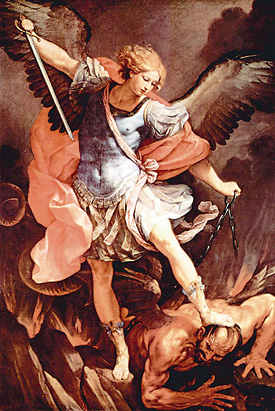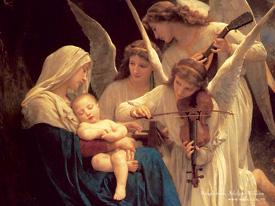Angels are everywhere today — on lapel pins, magnetic dashboard figures, keepsake ornaments and in a Pulitzer Prize-winning play. But interest in angels is more than a contemporary fad. According to a U-M historian, angels stirred intense interest in the early years of Christianity as well.
“Just as many people today think of pets as part of their families, many people in the first 500 years of Christianity were convinced that angels were part of their lives,” says Ellen Muehlberger, assistant professor of Near Eastern studies and history at LSA.


Above, Archangel Michael by Guido Reni, Church of Santa Maria della Concezione, Rome, 1636. Below, Song of the Angels by William Bouguereau, 1825-1905.
Various types of angels are named, but not defined, in the Bible. Christians worked out concepts of angelic identity and purpose during the fourth and fifth centuries, according to Muehlberger, who is writing a book on angels in late ancient times. An author living in Syria around the year 500 organized what little was known about angels into a “Celestial Hierarchy”: Seraphim, Cherubim, Thrones, Dominions, Virtues, Authorities, Principalities, Archangels and Angels.
In late antiquity, the identity of angels was much broader than what it is now: some Christians spoke of Christ as an angel, or suggested that Christian ascetic monks who renounced family, food, drink and sex, and lived out in the desert really were angels. But Muehlberger says when the Egyptian monks learned they were being considered angels, they emphatically rejected the idea.
“They said, ‘We act like animals, not angels,’” Muehlberger says.
The monastic emphasis on humility was in direct conflict with the reputation ascetics had as special, holy people, equal to the angels, she explains.
Exactly how angels looked and acted, and what humans could do to gain or lose their help, was a frequent topic of debate, Muehlberger says.
Most people did not envision angels looking the way we imagine them today — as beautiful winged creatures in diaphanous gowns.
“In antiquity, some Christians believed that angels were minds, or intellects, detached from bodies,” Muehlberger says. “In a way, angels were like computers — very, very good at figuring things out and getting things done because they had rational minds but did not have the difficulty of having desires and passions, like humanity.”
One of the most widespread modern notions about angels emerged in the late ancient era of Christianity that Muehlberger is studying. In those times, while some Christians assumed that guardian angels protected all human beings, others were convinced that they only were given to those who had demonstrated their virtue. These were “companion angels,” and not everyone had one.
While non-Christians also believe in angels, Muehlberger says the belief is especially prevalent today in Christianity, particularly in the United States.
“North American Christianity has always been innovative, adaptive and diverse,” she says. “I see the contemporary interest in angels as an example of this.”

